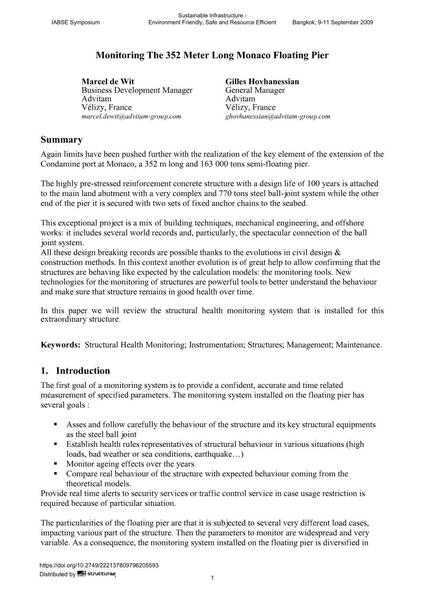Monitoring The 352 Meter Long Monaco Floating Pier

|
|
|||||||||||
Bibliographic Details
| Author(s): |
Marcel De Wit
Gilles Hovhanessian |
||||
|---|---|---|---|---|---|
| Medium: | conference paper | ||||
| Language(s): | English | ||||
| Conference: | IABSE Symposium: Sustainable Infrastructure - Environment Friendly, Safe and Resource Efficient, Bangkok, Thailand, 9-11 September 2009 | ||||
| Published in: | IABSE Symposium Bangkok 2009 | ||||
|
|||||
| Page(s): | 20-24 | ||||
| Total no. of pages: | 5 | ||||
| Year: | 2009 | ||||
| DOI: | 10.2749/222137809796205593 | ||||
| Abstract: |
Again limits have been pushed further with the realization of the key element of the extension of the Condamine port at Monaco, a 352 m long and 163 000 tons semi-floating pier. The highly pre-stressed reinforcement concrete structure with a design life of 100 years is attached to the main land abutment with a very complex and 770 tons steel ball-joint system while the other end of the pier it is secured with two sets of fixed anchor chains to the seabed. This exceptional project is a mix of building techniques, mechanical engineering, and offshore works: it includes several world records and, particularly, the spectacular connection of the ball joint system. All these design breaking records are possible thanks to the evolutions in civil design & construction methods. In this context another evolution is of great help to allow confirming that the structures are behaving like expected by the calculation models: the monitoring tools. New technologies for the monitoring of structures are powerful tools to better understand the behaviour and make sure that structure remains in good health over time. In this paper we will review the structural health monitoring system that is installed for this extraordinary structure. |
||||
| Keywords: |
management structures maintenance structural health monitoring Instrumentation
|
||||
